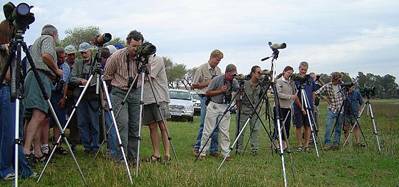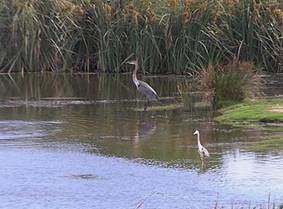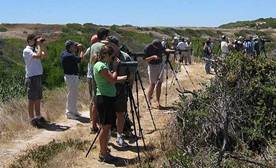SA Rare Bird News Report - 30 November 2009
Trevor Hardaker
|
|
|
|
S O U T H E R N A F R I C A N R A R E B I R D N E W S R E P O R T |
|
|
|
|
|
|
|
|
|
|
|
This is the Southern African Rare Bird News Report issued at 22h00 on Monday, 30 November 2009. Information has been gleaned from various websites, email groups as well as from individual observers who have passed on their sightings. This report cannot be taken as being totally comprehensive as it is based only on information made available at the time of writing. All bird sightings reported here are reported in good faith based on information as provided by the observers. Any inaccuracies are totally unintentional and the writer cannot be held liable for these. For those who may have only joined the group recently and are interested in finding out what has been seen in the past, previous reports can be viewed at http://groups.google.co.za/group/sa-rarebirdnews |
|
|
|
|
|
In the Western Cape, top honours in the last few days went to a BLACK-HEADED GULL in full breeding plumage discovered in Velddrif on Friday (This may well be the same individual seen at Geelbek in the West Coast National Park a couple of weeks ago). The bird was seen roosting on a sandbank in the Berg River opposite the Kuifkopvisvanger Chalets. Unfortunately, it was not present there throughout Saturday, but on Sunday morning, there was a report of the bird on the salt pan to the east of the R27, so it appears to be moving around a bit.
A single LESSER SAND PLOVER was still on view at Geelbek on the weekend showing well from the main hide yesterday. On Saturday, the GOLIATH HERON at Rondevlei Nature Reserve was still present whilst there was also a report of a pair of LESSER STRIPED SWALLOWS at the derelict bridge near the source of the Klein River on the Oudekraal Road (very close to van Brakel se stoor). |
|
|
|
|
|
|
|
|
Lesser Sand Plover at Geelbek © David Winter |
Goliath Heron at Rondevlei Nature Reserve © Hilary Anderson |
|
|
|
|
Single FULVOUS DUCKS were also reported from both the Varkensvlei and Phillipi Wetlands on Saturday while, in keeping with the waterfowl theme, a pair of HOTTENTOT TEALS at Plettenberg Bay Sewage Works were a little out of place too.
The influx of NAMAQUA DOVES southwards is also continuing with large numbers of birds reported all along the coastal strip from Rooiels through to the Uilenkraal estuary with the most southerly record being of 2 birds sitting on the beach at Danger Point! This species has also now been reported several times recently from Wildernis on the Garden Route. |
|
|
Hottentot Teals at Plettenberg Bay Sewage Works © Gill Jensen |
|
|
|
|
|
Into the Eastern Cape where a RED-BILLED OXPECKER was reported on a farm a short way south-west of Aliwal North this morning. The bird is apparently associating with the cattle on the farm.
Also of interest in the province, an AFRICAN OPENBILL was seen circling northwards over farmland at approx. 33 03.8 S 27 48.4 E (just north of Cove Rock, East London) on Saturday morning. The bird was seen again later in the day over East London Grand Prix Circuit. |
|
|
|
|
|
AFRICAN OPENBILLS also seem to be invading Kwazulu Natal at the moment with a singleton reported from Umzumbi on Saturday, 2 birds at Inchanga (halfway between Durban and Pietermaritzburg) also on Saturday, 2 birds present in Boston in the KZN Midlands and up to 20 birds present this morning near the Drakensberg Boy’s Choir School.
Other records of interest in the province included a WHITE-FRONTED BEE-EATER in the Monk’s Cowl region of the Drakensberg whilst small numbers of RED-HEADED QUELEAS were present throughout the weekend at the new La Mercy airport site north of Durban. |
|
|
Red-headed Quelea at La Mercy © David Allan |
|
|
|
|
|
Moving into Gauteng, both the CASPIAN PLOVERS and PALE-CROWNED CISTICOLAS were still present throughout the weekend. For the benefit of the many people that have emailed me to request directions to the sites, the Caspian Plovers are apparently 2.6km down the Palmietfontein road, which is about 5.5km before Devon on the R550. (Co-ordinates for this site are 26 24.743 S and 28 41.985 E.) The Pale-crowned Cisticolas are apparently around the start of this same road as well. |
|
|
|
|
|
In Limpopo Province, a YELLOW-RUMPED TINKERBIRD was reported from the Tzaneen area on Saturday and seems to be quite a bit further north than its usual range. The Tzaneen area also produced a MAGPIE MANNIKIN on Saturday although this species is probably resident in very small numbers here given the reports of this species from the area in recent times.
Continuing in the province, an AYRE’S HAWK EAGLE was reported from Crooks Corner near Pafuri in the Kruger National Park. Although not unknown from this area, it is certainly rather uncommon here. |
|
|
Ayre’s Hawk Eagle at Crooks Corner © Ken Logan |
|
|
|
|
|
Namibia is also still holding a number of good birds with 2 COMMON REDSHANKS still present at Mile 4 Salt Works near Swakopmund whilst Walvis Bay still has 1 COMMON REDSHANK, a BLACK-HEADED GULL and at least 15 RED-NECKED PHALAROPES.
Lastly, and this has nothing really to do with our local rarities, but is still vaguely related to twitching, I am not sure how many of you are aware of the attempt by Chris Gooddie to see all 32 species of Pittas in the world during the course of 2009. For any of you that have ever attempted to see a Pitta in the wild, I am sure you can imagine what a task this must be to try and see every species of Pitta. You can only imagine the kind of patience you must have to make this succeed!! Anyway, Chris has had huge success this year so far and has already racked up 31 species with the only one still outstanding being our very own AFRICAN PITTA. He heads off to Zambia (probably the best place in the world to chase down this species) next week to try and catch up with his last Pitta species. For those of you that might be interested in following his escapades or reading about what he has already managed to achieve, have a look at his website at www.pittasworld.com. |
|
|
|
|
|
Don’t forget to send through your details to be included on the various listing clubs that are hosted at www.zestforbirds.co.za. This website also has an extensive rarities gallery that has many additional photos of a number of rarities that are mentioned in these reports. |
|
|
|
|
|
|
|
|
|
|
|
Thank you to all observers who have contributed their records. Please continue to send through any reports of odd birds as well as continued updates on the presence of rarities already previously reported, no matter how mundane you think they may be. Even if you think someone else has probably sent in a report, rather send the report yourself as well. The only way to improve this service and to make it as useful as possible to everyone is if it can be as comprehensive as possible. |
|
|
|
|
|
Kind regards Trevor |
|
|
------------------------------------------------------------------------
TREVOR HARDAKER Cape Town, South Africa
See my wildlife photos at www.hardaker.co.za
ZEST for BIRDS Trevor Hardaker and John Graham Pelagics, rarity photos, listing clubs and more
SA RARE BIRD NEWS Get the latest rarity news by joining at: http://groups.google.co.za/group/sa-rarebirdnews
----------------------------------------------------------------------- |
|
|
|
|








